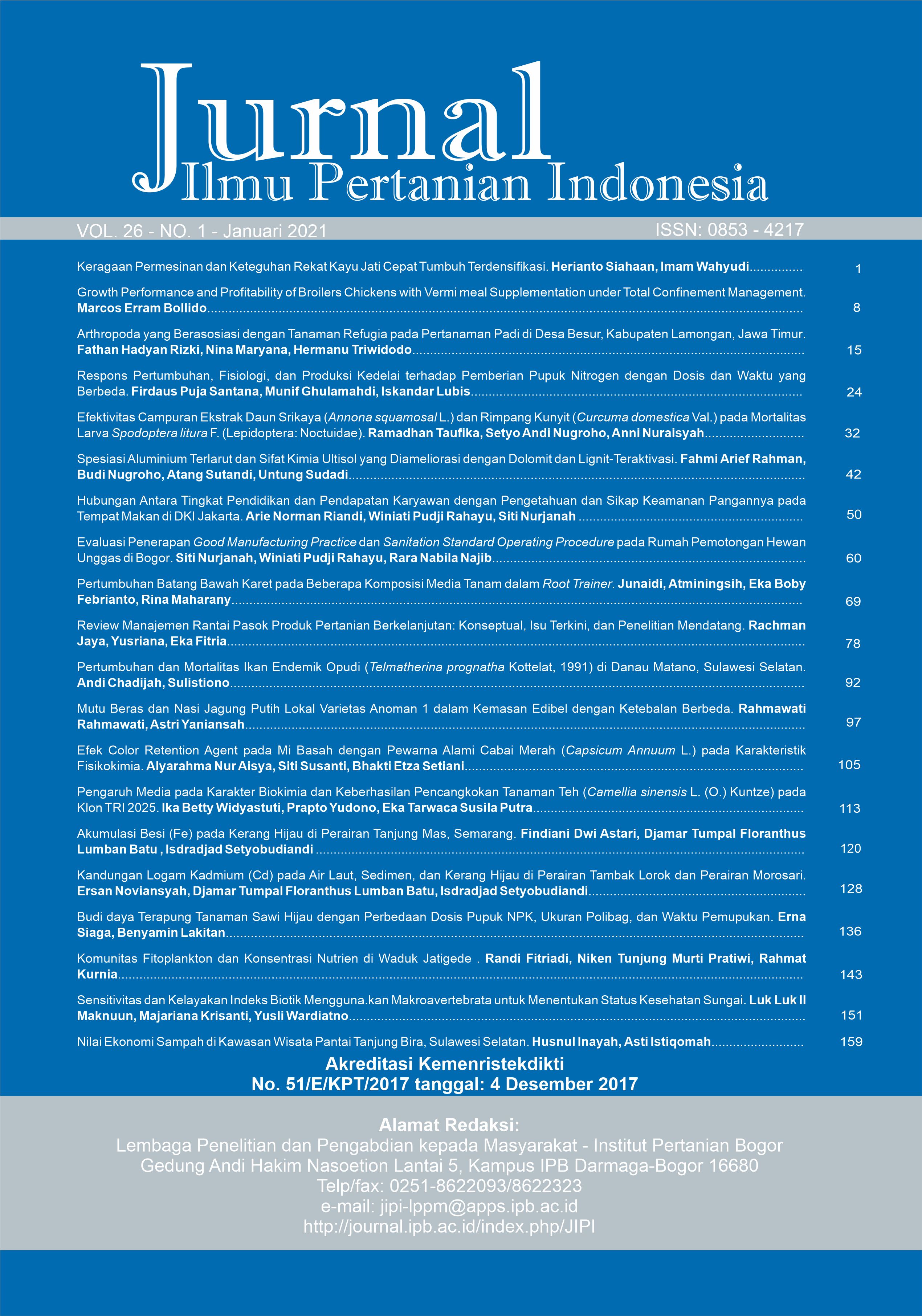Growth Performance and Profitability of Broilers Chickens with Vermi meal Supplementation under Total Confinement Management
Abstract
This study was conducted to determine the growth performance and profitability of broilers chicken with vermi meal supplementation under a total confinement management system. A total of 60 broiler chickens were randomly distributed to four dietary treatments: T1= commercial feed (CF), T2= CF+2% vermi meal (VM), T3= CF+3% VM, T4= CF+5% VM inclusion in a completely randomized design. Feed conversion ratio was not significantly influenced by VM supplementation. However, the highest feed intake was recorded in broilers fed CF supplemented with 2% VM (T2) while control broilers fed only CF (T1) had the lowest feed consumption. Broiler chickens fed CF supplemented with 2% VM (T2) were recorded with the highest values of final body weight and weight gain compared to T1 group and T4 group, respectively. However, broiler in T2 group had similar values of body weights and weight gains compared to T3. Consequently, 2% level of VM had an optimum result in final weight, weight gain, and feed consumption, while comparable to the other treatments in water consumption, feed conversion ratio, dressing percentage, and carcass weight. Cost and return analysis of the dietary treatments with VM showed a negative effect, since the higher concentration of VM supplementation had the higher cost in production, due to the expensive price of imported vermin or earthworm meal.
Keywords: broiler chickens, performance, total confinement, vermi meal
Downloads
References
Bahadori Z, Esmaielzadeh L, Karimi-Torshizi MA, Seidavi A, Olivares J, Rojas S, López S. 2017. The effect of earthworm (Eisenia foetida) meal with vermi-humus on growth performance, hematology, immunity, intestinal microbiota, carcass characteristics, and meat quality of broiler chickens. Livestock Science. 202: 74–81. https://doi.org/10. 1016/j.livsci.2017.05.010
Bahadori Z, Esmaylzadeh L, Torshizi MAK. 2015, January. The effect of earthworm (Eisenia fetida) and vermihumus meal in diet on broilers chicken efficiency and carcass components. In Biological Forum. 7(1): 998.
Dedeke GA, Owa SO, Olurin KB, Akinfe AO, Awotedu OO. 2013. Partial replacement of fish meal by earthworm meal (Libyodrilus violaceus) in diets for African catfish, Clarias gariepinus. International Journal of Fisheries and Aquaculture. 5(9): 229–233.
Julendra H, Damayanti E, Lusty Istiqomah SN, Karimy MF. 2012. The effectiveness of earthworm meal supplementation as antibiotic growth promoter replacer with different processing method. The First Poultry International Seminar, pp 146–157.
Gunya B, Muchenje V, Masika PJ. 2019. The potential of Eisenia foetida as a protein source on the growth performance, digestive organs size, bone strength and carcass characteristics of broilers. Journal of Applied Poultry Research. 28(2): 374–382. https:// doi.org/10.3382/japr/pfy081
Khajavi HR, Karimi TMA, Ahmadi H. 2015. Effect of feeding different levels of dietary vermihumus on growth performance and meat quality in broiler chickens. Journal of Animal Production. 16: 49–58.
Köse B, Öztürk E. 2017. Evaluation of Worms as a Source of Protein in Poultry. Selcuk Journal of Agriculture and Food Sciences. 31(2): 107–111. https://doi.org/10.15316/SJAFS.2017.27
Lourdumary AB, Uma K. 2013. Nutritional evaluation of earthworm powder (Lampito mauritii). Journal of Applied Pharmaceutical Science. 3(3): 82.
Mahamba TA. 2018. Effect of Earthworm (Eisenia Foetida) Protein Based Diet as a Supplement for Village Chicken Egg Production in Gutu District, Masvingo (Doctoral dissertation, BUSE).
Mengist BK. 2016. Evaluation of Earthworm (Eisenia fetida) as a Protein Supplement for Chicken Production in Haramaya University Poultry Farm. Thesis.
Nalunga A. 2019. Earthworms (Eudrilus Eugeniae) as a potential source of proteins in poultry feeds (Doctoral dissertation, Makerere University).
Ncobela CN, Chimonyo M. 2015. Potential of using non-conventional animal protein sources for sustainable intensification of scavenging village chickens: A review. Animal Feed Science and Technology. 208: 1–11. https://doi.org/10.1016/ j.anifeedsci.2015.07.005
Olawumi, S.O. and Fagbuaro, S.S., 2011. Productive performance of three commercial broiler genotypes reared in the derived savannah zone of Nigeria. International Journal of Agricultural Research. 6(11): 798–804.
[PSA] Philippines Statistics Authority. 2020. Chicken Situation Report, January-March 2020. Philippine Statistics Authority (PSA). https://psa.gov.ph/ livestock-poultry-iprs/chicken.
Prayogi HS. 2011. The effect of earthworm meal supplementation in the diet on quail's growth performance in attempt to replace the usage of fish meal. International Journal of Poultry Science. 10(10): 804–806. https://doi.org/10.3923/ ijps.2011.804.806
Rezaeipour V, Nejad OA, Miri HY. 2014. Growth performance, blood metabolites and jejunum morphology of broiler chickens fed diets containing earthworm (Eisenia foetida) meal as a source of protein. International Journal of Advanced Biological and Biomedical Research. 2(8): 2483–2494.
Sultan BE, Bowes EH, van der Walt JC. 2010. Influence of different housing systems on the performance of hens of four laying strains. South African journal of animal science. 25: 80–86.
Tiroesele B, Moreki JC. 2012. Termites and earthworms as potential alternative sources of protein for poultry. International Journal for Agro Veterinary and Medical Sciences (IJAVMS). 6(5): 368–376. https://doi.org/10.5455/ijavms.174
Vu Dinh T, Han Quang H, Nguyen Dinh L, Van Duy N. 2009. Use of redworms (Perionyx excavatus) to manage agricultural wastes and supply valuable feed for poultry. Livestock Research for Rural Development. 1‒8.
Zang YT, Bing S, Zhang YZ, Sheng XW, Shu DQ. 2018. Effects of dietary supplementation with earthworm powder on production performance, blood characteristics, and heavy metal residues of broiler Pullets. Journal of Applied Poultry Research. 27(4): 609–615. https://doi.org/10.3382/ japr/pfy024
Zhu Y, Li W, Zhang Y, Cao M, Wang C. 2010. Effect of earthworms powder on growth performance, metabolic rate and immune functions of broilers. Journal of Shenyang Agricultural University. 41(6): 695–700.
This journal is published under the terms of the Creative Commons Attribution-NonCommercial 4.0 International License. Authors who publish with this journal agree to the following terms: Authors retain copyright and grant the journal right of first publication with the work simultaneously licensed under a Creative Commons Attribution-NonCommercial 4.0 International License. Attribution — You must give appropriate credit, provide a link to the license, and indicate if changes were made. You may do so in any reasonable manner, but not in any way that suggests the licensor endorses you or your use. NonCommercial — You may not use the material for commercial purposes.























